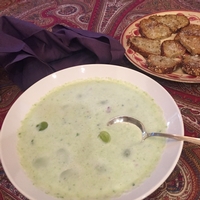WINE WITH…White Gazpacho
It has been a hot summer in the northern hemisphere. On the most sweltering evenings we yearn for cool food, but we’ve had enough chunky chicken salad and tuna sandwiches for a while. We crave a break from all the big, leafy

salads we’ve been grazing on…but we don’t want to turn on the stove or even fire up the grill. In short, what we need is chilled, delicious and nutritious gazpacho.
We might opt for a traditional tomato infused red gazpacho, or for the beautiful emerald-green arugula-based chilled soup we made earlier in the season, but on a recent steamy evening we went with white gazpacho. Refreshingly pale, icy cold and delectable, this lovely soup may not be the antidote to global warming, but it does make the scorching summer a little more pleasant.
White Gazpacho
Make the gazpacho at least 3 hours or even a day ahead to allow the soup to chill thoroughly and the flavors to blend together.
3 English-type seedless cucumbers, peeled and cut in 1 to 2-inch pieces (should yield
about 3 cups chopped cucumber)
2-3 cloves garlic, minced
2 cups chicken stock (or vegetable stock)
1 cup plain, unsweetened yogurt, preferably whole milk
3 tablespoons white wine vinegar (or sherry vinegar or cider vinegar)
1/2 Poblano pepper seeded and chopped (use a whole pepper for spicier results)
1 and 1/2 cups chopped red onion
1/2 cup heavy cream
1 and 1/2 cups green grapes, halved
Put the cucumber, garlic and about one cup of the stock in a blender or food processor. Process for a couple of minutes, scraping down the bowl as needed, until the mixture is thoroughly pulverized. Add 1 teaspoon salt; then pour the mixture into a large bowl or pitcher. Whisk in the yogurt and stir in the vinegar and the remaining stock. Place the chopped poblano pepper and red onion in the blender and pulse on and off, scraping down the bowl as needed, until the mixture is very finely minced but not liquefied. Stir this mixture into the ingredients in the bowl and whisk in the cream. Taste for seasoning and chill thoroughly. To serve, ladle the soup into bowls and add about half of the grapes. Put the remaining grape halves in a small bowl and pass at the table to be added as needed.
* * *
We found it very difficult to pair wine successfully with this refreshing but rich soup. At first, we thought that wines with an herbal edge (think New Zealand Sauvignon or Pinot Bianco from northeastern Italy) would work, but we found that the gazpacho made them taste bitter. Then we tried heavier, richer wines (Chardonnay, Semillon, and Viognier), but they seemed sour and more important, cumbersome. We liked a dry bubbly, as much for the textural contrast as the flavors, and a slightly sweet Chenin Blanc, as well as a California Sauvignon (richer than the French and New Zealand renditions we tried), but to be honest, we have to confess that most wines proved disappointing. Then we remembered that Spaniards, who after all invented gazpacho, often drink chilled Vermouth on hot days. We tried one, and it was delicious, as was an aromatized Bianco from Italy. Just as this dish offers unexpected pleasures, so too did our wine tastings with it. Our palates simply did not match our expectations.